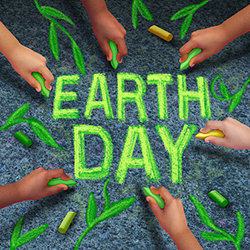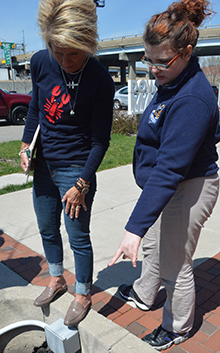Teacher Mary Lewandoski remembers a student making a firm statement while studying endangered species: “It’s all because of humans.”
“Save that thought,” Lewandoski recalled telling her.
That realization would come again and again in studying sediment in streams, pollution and other environmental issues.
“Anything we do is going to impact it, whether it’s the warming of the Earth, losing habitat or air pollution,” said Lewandoski, a grades 6-8 teacher at C.A. Frost Environmental Science Academy.
That student made a conclusion shared by most scientists when it comes to issues affecting the planet: human interaction is the primary cause. But it’s one that’s strongly resisted by the Trump administration and climate-change deniers, who are pushing to lift environmental regulations designed to reduce pollution and slow global warming.
In late March, President Trump signed an executive order to nullify Barack Obama’s climate-change efforts on the Clean Power Plan, which aimed to cut emissions from coal- and gas-fired power plants. Scott Pruitt, the newly appointed head of the Environmental Protection Agency, has said carbon dioxide is not a primary contributor to global warming, a statement at odds with the established scientific consensus on climate change.

With regulations under threat and top government administrators questioning human impact on climate, science teachers have their work cut out for them.
On such a politically charged issue, they try not to push their views on students, but to teach them how to tell scientific fact from misinformation — and realize their own impact on the planet.
Teaching students to be able to support claims with accurate data is imperative, Lewandowski said, but she fears it’s becoming an under-utilized skill.
“(People) don’t know what information is true or not, and they just say anything out there is the truth,” she said. “People put anything and everything out there, and the kids are just so constantly on technology.
“For me, the reason I came into education, sad as it is to say, it is in fruition now. It has blossomed into this huge invasive plant. It has taken over the ability to think.”

Just the Facts, Please
Teachers elsewhere also emphasize the importance of separating fact from opinion, and legitimate sources from unreliable ones.
At Kelloggsville High School, John Linker stresses the need to be informed and gather information based on fact.
“My job as a scientist is to present the facts, whether I wholeheartedly believe climate change Armageddon is happening, or I’m on the other side and I think it’s a bunch of B.S,” said Linker, who teaches earth science, biology and chemistry. “I want the kids to look at ‘Here’s what we know to be true; here are the sides that argue about it; these are the holes in it,’ and be able to make decisions.”
Linker says he teaches students where to find good information.
“What we really need to do is know who your sources are,” he said, noting that he urges students to rely on .gov and .edu sites. “What’s a little bit tough for a science teacher is we are kind of at the mercy of people doing the research. We are going to take their word that the research they do is factual, legit data that they are publishing.”
Linker studied glaciers in Alaska while a Michigan State University graduate student. A committee member on his thesis was Richard Alley, a prominent climate scientist at Penn State University who has testified before government panels.
“Over 90 percent of glaciers around the world are receding,” Linker said. “There are some that aren’t, and those are the ones that your anti-climate change people point to. … (But) when you have that majority that are, that raises questions as to why.”
He shows students a TED Talk video of a time lapse of a receding glacier.
“It’s no longer a question of if it’s happening,” Linker said. “We can keep arguing about the cause of it, but it’s kind of mindless now. We are in the midst of it. How do we deal with it?”
Misinformation that gets spread seems just plausible enough that it could be true, he said, adding his job is to give students enough education and good information sources to tell the difference.
“In a couple years they are going to be able to vote, and hopefully they know what they are voting for.”

Science and Caring for Creation
At C.A. Frost, which has an environmental focus, Lewandoski doesn’t teach topics in isolation. The study of weather can branch out in many directions, involving water, habitats, even the chemistry of a snowflake. Recycling, water conservation and investigating nearby woods and streams is part of students’ daily routine.
While politics infringes on science nationally, Lewandoski is more focused on educating students so they become well-informed stewards of the planet — and learn how to have healthy interactions with nature.
“My goal as an environmental teacher is for them to realize the importance they make in our world, and looking at sustainability practices and what they can do to make a difference so the world is healthy.”
The environment has long been Lewandoski’s passion. The desire to protect it is a big reason she’s a teacher, she said.
Prior to teaching, she spent eight years working for the Department of Environmental Quality as an analyst for groundwater contamination caused by underground storage tanks. Many adults she interacted with, often at gas stations where old, leaking tanks had to be removed, didn’t understand possible impacts on the environment.
She sees that happening still, and on a national stage.
“It makes it even more important that kids understand the connection of human interaction with the Earth. That there are so many adults out there who don’t understand that; the way they act and what’s being said, it is alarming.”

Creating Lifelong Environmental Stewards
Her students are among many in Kent County who work with Groundswell, an initiative made up of community partners through Grand Valley State University that emphasizes outdoor learning about the watershed.
At University Prep, a college preparatory school in Grand Rapids Public Schools, seventh- through ninth-graders are involved in a Groundswell project to create a native plant bioswale. That’s a drainage course made up of landscape elements, designed to concentrate or remove silt and pollution from surface-water runoff on the school site at 512 S. Division.
Students make connections between human activity and resource depletion and contamination.
“If you use it and abuse it, we are going to lose it,” stresses sixth- and seventh-grade science teacher Sherri Kraai.
Seventh-graders recently took a field trip to Grand Rapids Downtown Market, 435 Ionia Ave. SW, to join a Groundswell representative in observing the bioswales on the site and a natural urban wetland.
Student Journey Berkenpas said she’s learning about how design elements like bioswales purify water before it gets to the Great Lakes. When it comes to climate change, Journey said she hopes lessons on the environment will help young people to care.
“I know it is something that is changing the climate of each place,” she said, adding she’s learned about melting ice caps and rising sea waters. “It inspires me to learn more about Earth, nature and how to protect it.”
Kraai teaches about global warming through researching its definition and consequences. Students have experimented with ice, and considered the effects of Arctic ice melt. “It was a great visual for the kids,” she said. “‘This is what’s going on: The polar bears are losing their home.'”
The No. 1 question a scientist must always ask is “why?,” Kraai tells students. “Be curious, get the facts before you make the assumptions. You need to have evidence, proof, five to 10 sources.”

It’s All Related
Christopher Reeve, an eighth-grade social studies teacher at UPrep, is leading the Groundswell project there and sees its cross-curricular potential.
“Anything that deals with the environment can be brought into any subject because it has such a wide-reaching impact on our world today,” Reeve said.
Reeve says using a historical lens on environmental issues is important. “You can definitely look at the way the world was and the way the world is now, as technology has advanced and population has increased.
“Obviously the political side of it comes into play in social studies,” he said. “It comes back to ‘Can you prove this is happening? What evidence specifically can you cite to support what you’re claiming?'”
He said the best learning occurs when students become interested and connected.
“Letting students come to a solution on their own, they are going to be more passionate about it. When you can involve an environmental issue, a real-world issue with that, it’s kind of like the perfect storm.”
CONNECT









